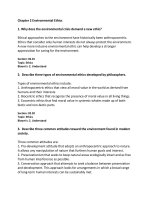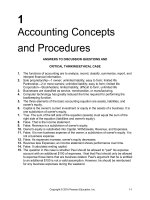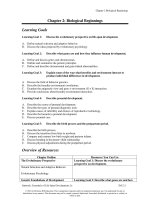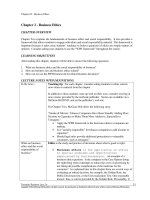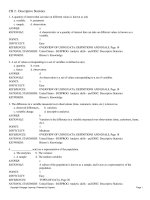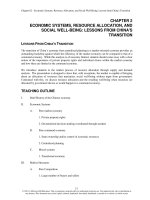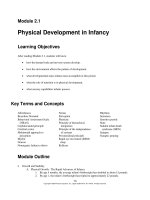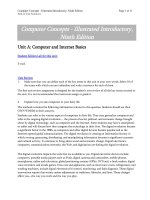Test bank and solution manual of computer concepts 9e (1)
Bạn đang xem bản rút gọn của tài liệu. Xem và tải ngay bản đầy đủ của tài liệu tại đây (458.98 KB, 11 trang )
Computer Concepts - Illustrated Introductory, Ninth Edition
End of Unit Solutions
Page 1 of 11
Computer Concepts - Illustrated Introductory,
Ninth Edition
Unit A: Computer and Internet Basics
1.
Make sure that you can define each of the key terms in this unit in your own words. Select 10 of
the terms with which you are unfamiliar and write a sentence for each of them.
The first unit review assignment is designed for the student’s own review of all the key terms covered in
the unit. It is not recommended that instructors assign or grade it.
2.
Explain how you use computers in your daily life.
The textbook contains the following information relevant to this question. Students should use their
OWN WORDS in their answers.
Students can refer to the various aspects of computers in their life. They may generalize computers and
refer to the ongoing digital revolution--- the process of social, political, and economic change brought
about by digital technology, such as computers and the Internet. Some students may have a smartphone
or tablet and will discuss how they integrate the technology in their lives. The digital revolution became
a significant factor in the 1980s, as computers and other digital devices became popular and as the
Internet opened global communications. The digital revolution is creating an Information Society in
which owning, generating, distributing, and manipulating information becomes a significant economic
and cultural activity. It continues to bring about social and economic change. Digital electronics,
computers, communications networks, the Web, and digitization are fueling the digital revolution.
The digital revolution impacts the tools that are available to you. Digital electronic devices include
computers, portable media players such as iPods, digital cameras and camcorders, mobile phones,
smartphones, radios and televisions, global positioning systems (GPSs), DVD and, e-book readers, digital
voice recorders, and arcade games. Even cars and appliances, such as microwave ovens, refrigerators, and
washing machines, include digital electronics for control, monitoring, and fault diagnosis. These digital
innovations require that society makes adjustments to traditions, lifestyles, and laws. These changes
affect you—the way you work and the way you play.
Computer Concepts - Illustrated Introductory, Ninth Edition
End of Unit Solutions
3.
Page 2 of 11
Explain the basic functions of a computer: input, processing, storing, and output. Explain why the
stored program concept is important to computers.
The textbook contains the following information relevant to this question. Students should use their
OWN WORDS in their answers.
Computer input is whatever is put into a digital electronic device or computer system. A person can
supply input, the environment can, or another computer can. Examples of the kinds of input that a
computer can accept include the words and symbols in a document, numbers for a calculation, pictures,
temperatures from a thermostat, an image from a digital camera, audio signals from a microphone, and
instructions from a computer program. An input device, such as a keyboard or mouse, microphone,
camera, scanner, gathers input and transforms it into a series of electronic signals that the computer can
work with.
In the context of computing, data refers to the symbols that represent facts, objects, and ideas.
Computers manipulate data in many ways, and we call this manipulation processing. The series of
instructions that tell a computer how to carry out processing tasks are referred to as a computer program,
or simply a “program.” These programs form the software that sets up a computer to do a specific task.
Some of the ways that a computer can process data include performing calculations, sorting lists of words
or numbers, modifying documents and pictures, and drawing graphs. In a computer, most processing
takes place in a component called the central processing unit (CPU), which is sometimes described as the
“brain” of the computer.
A computer stores data so that it will be available for processing. Most computers have more than one
location for storing data, depending on how the data is being used. Memory is an area of a computer that
temporarily holds data that is waiting to be processed, stored, or output. Storage is the area where data
can be left on a permanent basis when it is not immediately needed for processing.
Output is the results produced by a computer. Some examples of computer output include reports,
documents, music, graphs, and pictures. An output device displays, prints, or transmits the results of
processing. Figure A-3 helps you visualize input, processing, storage, and output activities of a computer.
4.
Identify and describe the purpose of each of the components of a basic personal computer system.
Computer system unit. The system unit is the case that holds the main circuit boards,
microprocessor, power supply, and storage devices. The system unit for most notebook
computers holds a built-in keyboard and speakers, too.
Display device. Most desktop computers use a separate monitor as a display device,
whereas notebook computers use a flat-panel LCD screen (liquid crystal display) that is
attached to the system unit.
Keyboard. Most computers are equipped with a keyboard as the primary input device. A
keyboard is typically onscreen for a tablet computer and smartphone.
Mouse. A mouse is an alternative input device designed to manipulate on-screen
graphical objects and controls.
Hard drive. A hard drive can store billions of characters of data. It is usually mounted
inside the computer’s system unit. A small external light indicates when the drive is
reading or writing data.
Computer Concepts - Illustrated Introductory, Ninth Edition
End of Unit Solutions
5.
Page 3 of 11
CD-ROM, BD (Blu-ray drive), or DVD drive. CD BD and DVD drives are optical storage
devices that use laser technology to read data that is permanently stored on computer or
audio CDs, DVDs, or BDs. A DVD drive can read data from computer CDs, audio CDs,
computer DVDs, or DVD movie disks. CD-ROM and DVD drives typically cannot be
used to write data onto disks. The “RO” in “ROM” stands for “read only” and means that
the drive can read data from disks, but cannot be used to store new data on them.
CD/DVD-writer. Many computers—especially desktop models—include a CD/DVDwriter that can be used to create and copy CDs and DVDs.
Sound card and speakers. Desktop computers have a rudimentary built-in speaker that’s
mostly limited to playing beeps. A small circuit board, called a sound card, is required for
high-quality music, narration, and sound effects. A desktop computer’s sound card sends
signals to external speakers. A notebook’s sound card sends signals to speakers that are
built into the notebook system unit.
Modem. Virtually every personal computer system includes a built-in modem that can
be used to establish an Internet connection using a standard telephone line.
Printer. A computer printer is an output device that produces computer-generated text
or graphical images on paper.
Web cam. Allows you to capture video images using your computer. Software makes it
possible to send and receive video in real time with another person to communicate with
voice as well as images.
Describe the difference between an operating system and application software.
The textbook describes the difference as: Application software is a set of computer programs that helps a
person carry out a task. Word processing software, for example, helps people create, edit, and print
documents. Personal finance software helps people keep track of their money and investments. Video
editing software helps people create and edit home movies—and even some commercial release films.
An operating system is essentially the master controller for all of the activities that take place within a
computer. Operating systems for desktop, notebook, and netbooks include Windows and Mac OS X (for
the Mac computer). The Windows operating system was designed specifically for PCs. The PC platform
is sometimes called the Windows platform. The Macintosh OS was designed specifically for Macintosh
computers, which are based on a proprietary design and manufactured almost exclusively by Apple
Computer, Inc. Mobile devices such as smartphones and tablets have propriety operating systems that
perform similarly in that they control the device. Operating systems are classified as system software,
not application software, because their primary purpose is to help the computer system monitor itself in
order to function efficiently. Unlike application software, an operating system does not directly help
people perform application-specific tasks, such as word processing. People do, however, interact with
the operating system for certain operational and storage tasks, such as starting programs and locating
data files.
The textbook explains a graphical user interface as follows: A GUI, such as the one associated with the
Windows OS, the Mac OS, or the Linux OS, displays on-screen icons, menus, buttons, and other
Computer Concepts - Illustrated Introductory, Ninth Edition
End of Unit Solutions
Page 4 of 11
graphical controls. These controls are designed to be manipulated by a mouse. For example, you might
click an icon to start an application program, or drag time slots on a calendar to create appointments.
Apps are software programs designed to run on mobile devices, such as a tablet or smartphone.
Some common features of a graphical user interface are icons, menus, buttons, and other graphical controls.
6. Explain why the stored program concept is important to computers.
In a modern computer, the idea of a stored program means that a series of instructions for a computing task
can be loaded into a computer’s memory. These instructions can easily be replaced by a different set of
instructions when it is time for the computer to perform a different task. Programs can be stored locally on
your computer. An emerging trend is to use programs stored in the cloud. The cloud is mass storage on
remote computers. The stored program concept allows you to use your computer for one task, such as word
processing, and then easily switch to a different type of computing task, such as editing a photo or sending
an e-mail message.
7. List at least three activities that are not communications related and that you can accomplish
using the Internet. If you have used the Internet, write a brief paragraph explaining how you
benefitted from using it. Students should include at least three of the following:
Web sites. Most people envision Web sites as locations in cyberspace that correspond to a corporation’s
headquarters, a store, a magazine, or a library. A Web site can provide information or it can provide
access to other resources, such as search engines and e-mail.
Search engines. Without search engines, using the Internet would be like trying to find a book in the
Library of Congress by wandering around the stacks. Search engines help catalog a huge portion of the
data stored on servers that are connected to the Internet.
E-commerce. The Internet is revolutionizing business by directly linking consumers with retailers,
manufacturers, and distributors. E-commerce, or “electronic commerce” includes such activities as
online shopping, electronic auctions, and online stock trading.
Downloads and uploads. Internet servers store all sorts of useful files, containing documents, music,
software, videos, animations, and photos. The process of transferring one of these files from a remote
computer, such as a server, to a local computer, such as your personal computer, is called downloading.
Sending a file from a local computer to a remote computer is called uploading.
Broadcasting and Podcasting. The Internet carries radio shows and teleconferences that can be broadcast
worldwide. These technologies are popular because broadcasts aren’t limited to a small local region, but
instead can be heard by listeners all over the world.
8. Make a list of at least three different ways you can use the Internet to communicate with other
people. Students should include at least three of the following:
Email: Benefits of email is that they are delivered immediately and are an inexpensive form of
communication. You do not need to be at your computer to receive email; you don’t have to be present
or available to receive email communications and you can read and reply to email when you’re ready.
You can use email to send files, such as documents, videos, and photos.
Computer Concepts - Illustrated Introductory, Ninth Edition
End of Unit Solutions
Page 5 of 11
Chat groups and instant messaging. A chat group consists of several people who connect to the Internet
and communicate by typing comments to each other using their computer keyboards. A private version
of a chat room, called instant messaging, allows two or more people to send typed messages back and
forth.
Internet telephony. As simple as picking up the telephone, Internet telephony—also called Voice over
IP (VoIP) allows telephone-style conversations to travel over the Internet to virtually anywhere in the
world. Internet telephony, such as Skype requires special software at both ends of the conversation and,
instead of a telephone, it uses a microphone connected to a computer. When using Internet telephony,
the sound quality is often as good as a cellular phone, and the price—free—is right.
Internet forums: Web sites where you can post comments to discussion threads.
Blogs. Short for “Web Logs,” Blogs are journals or other records posted by individuals for the public to
read and comment on.
Wikis. Collaborative Web sites that allows people to add to and modify material posted by others.
Social Networking. Social Networking sites such as Facebook and LinkedIn provide Web sites for
collaboration of ideas. It’s become a very popular way for people to meet, interact, and share ideas,
pictures, videos, and random thoughts.
Text and Multimedia messages: Sending typed messages or photos and video using a smartphone, or
mobile device. Depending on the service, text messages can be 140 to 160 characters or less. You can
send text messages by using the Web sites of their mobile provider.
9.
Describe the components of a URL.
Every Web page has a unique address called a URL (uniform resource locator). Most URLs begin with
http://. Some begin with https://. Examples would be www.google.com or www.cengage.com.
URLs can contain the subdirectory and file name of a document, whereas an e-mail address
simply refers to the name of the e-mail user and server. The four main parts are:
Web protocol standard/ Web server name/ Folder name/ Document name(dot)file extension
10. List the advantages and disadvantages of at least three types of computers and why you might
choose one over the other as described in this unit.
Workstations are usually powerful desktop computers designed for specialized tasks that require a lot of
processing speed. These high-end computers would be used professionally. Most are designed for
creating and displaying three-dimensional and animated graphics.
Desktop computer: A low-cost computer that fits on your desk. It is a computer that takes up space on a
desk and it not portable. It comes with a separate keyboard, mouse, and monitor. Connectivity to the
Internet is often provided through a wired system.
Notebook computer: Also called laptop computer, a portable computer that combines the display and
keyboard in one unit. You can add a mouse to most notebooks if you don’t want to use the touchpad that
comes built in. Notebooks are heavier than tablets or netbooks but also provide more storage and power.
Computer Concepts - Illustrated Introductory, Ninth Edition
End of Unit Solutions
Page 6 of 11
Most include wireless internet connectivity as well as wired options. Notebooks are designed to be
carried from place to place.
Tablet computer: A portable computer with an onscreen keyboard. Small and light enough to fit in a
pocketbook, these are lighter than notebook computers but do not have storage ability. Include built in
wireless connectivity to the Internet. Most do not include any way to save data files.
Smartphone: Mostly used for connectivity and communications, very small and light, fit in a pocket. Do
not include any way to save data files.
Computer Concepts - Illustrated Introductory, Ninth Edition
End of Unit Solutions
Page 7 of 11
Highlighted answer is the correct answer.]
[Page Reference in book is listed in brackets after the question.]
1. Which of the following is not a type of personal computer? [7]
a. mainframe
c. desktop
b. notebook
d. netbook
2. The part that is considered the brains of the computer is called the ___________ processing unit. [5]
a. main
c. operating
b. central
d. local
3. The idea of stored programs means that instructions for a computing task can be loaded into a
computer’s___________. [5]
a. hard drive
c. operating system
b. software
d. memory
4. The system ___________ houses important parts such as the circuit boards, processor, power supply, and
storage devices.[2]
a. processor
c. drive
b. memory
d. unit
5. A device that expands a computer’s capability is called a(n) ___________ device.[3]
a. input
c. output
b. peripheral
d. processing
6. A ___________ is a computer device that makes it possible to send video.[9]
a. netbook
c. mp3 player
b. scanner
d. Web cam
7. A(n) ___________ system is the software that acts as the master controller for all of the activities that take
place within a computer system.[10]
a. application
c. digital
b. processor
d. operating
8. A computer ___________ consists of two or more computers and other devices that are connected for the
purpose of sharing data and programs.[9]
a. system
c. netbook
b. network
d. hardware
9. Android is a type of___________ .[11]
a. power supply
c. blog
b. operating system
d. network
10. A ___________ is the system unit of choice for computer owners who want to upgrade because it is easy to
get inside and swap parts.[6]
a. tower unit
c. netbook
b. notebook
d. PDA
Computer Concepts - Illustrated Introductory, Ninth Edition
End of Unit Solutions
Page 8 of 11
11. The often provides a clue to the contents of a file. [5]
a. browser
c. filename
b. application
d. operating system
12. A computer uses a touch screen keyboard for typing.[7]
a. desktop unit
c. tower unit
b. notebook
d. tablet
13. A(n) ___________ is a personal journal posted on the Web for access by the public.[13]
a. chat
c. instant message
b. email
d. blog
14. An email account has a unique address that typically consists of a user ID, the symbol, and the name of the
computer that maintains the mailbox.[14]
a. X
c. @
b. *
d. #
15. Every Web page has a unique address called a(n) ___________.[12]
a. ARL
c. RUL
b. URL
d. LUR
16. Facebook and LinkedIn are examples of Web sites that provide social ___________.[15]
a. chatting
c. networking
b. blogging
d. email
17. To find information on the Web, it is best to use a ___________ engine. [13]
a. Web
c. search
b. home
d. program
18. A Web___________ is a series of Web pages on a specific topic.[13]
a. blog
c. site
b. group
d. URL
19. Digital___________ is the trend in which several technologies with distinct functionalities evolve to form a
single product.[3]
a. revolution
c. divide
b. electronics
d. convergence
20. A(n) ___________ is any word or phrase that you type in a search engine to describe the information that
you are trying to find.[13]
a. keyword
c. verb
b. adjective
d. Wiki
Computer Concepts - Illustrated Introductory, Ninth Edition
End of Unit Solutions
Page 9 of 11
Independent Challenge 1
Students were instructed to:
1. Write a one-page paper describing the computer that they use most frequently.
2. Use the Key Terms list from this unit to describe their computer’s components and the function
of each.
3. Prepare a final draft, underlining each Key Term used in their paper.
4. Submit the paper according to the instructor’s directions.
Making the assignment: This project should be assigned to individuals. Make sure that you tell your
students how they should submit this project: by e-mail, on disk, or as hard copy. If students do not have
access to a computer at home, provide them with samples in the lab or classroom if possible that they
can use. The image of the Webopedia Web site is provided to assist the students if they want to use the
Web to help with terms.
Deliverables: The paper will be ONE page long in a word processing format or printed.
Grading:
50 points = accuracy in describing their personal computer’s components
25 points = completeness of each component’s description (including its functions)
25 points = proper use of key terms from this unit
Independent Challenge 2
Students were instructed to:
1. Write 10 questions on index cards to be used in a game show.
2. Write the answer to each question on the back and the page reference in the text where it can be
found.
3. Quiz each other in small groups.
Making the assignment: This project should be assigned to individuals, who then form small-groups to
quiz each other. Students should put their name on each card and place it in an envelope with their
name on it.
Deliverables: 10 index cards:
2 simple questions, 5 medium questions, 3 difficult questions
The answers and page references should be on the back
Grading:
50 points = quality of their questions
25 points = completeness of their solutions
25 points = participation in small group quiz sessions
Computer Concepts - Illustrated Introductory, Ninth Edition
End of Unit Solutions
Page 10 of 11
Independent Challenge 3
1. Students are asked to use the Internet or any magazines to research the latest offerings in
smartphones and tablet computers.
Deliverables: completed table- outline provided in the text.
Completed table with information on three smartphones and three tablet computers.
Information should include a comparison of the apps and features that come with each tablet or
that are available for each tablet. It should also list the type of network required for each digital
device
Concluding paragraph explaining the decision to purchase either a smartphone or a tablet.
Supported facts for decision based on findings
Grading:
50 points = quality of their information
25 points = if they provided complete information
25 points = any additional notes or information and questions
Guide to Buying a Computer
Students were instructed to:
1. Browse through computer magazines and then name three magazines and three online resources they
have reviewed.
2. Think about how much they want to spend on a computer system and whether or not they would be
willing to buy older or used technology to meet a budget. They should decide on a budget and stick and
provide the range on the line provided. Budget range is $__________.
3. Make a list of three ways they plan to use a computer.
4. Students were instructed to fill in a table to complete a portion of a Guide to Buying a Computer.
Making the assignment: This project should be assigned to individuals. Students should fill in the table
in the textbook.
Deliverables: Completed table.
Grading:
Computer Concepts - Illustrated Introductory, Ninth Edition
End of Unit Solutions
Page 11 of 11
75 points = quality of their notes
25 points = page references
25 point = questions that are thoughtful
Based on the image in the Figure students can set up their own Web-based email account:
1. Students should follow onscreen instructions to get a Web-based email account using a student’s own
computer, or a public computer if you do not own a computer, yet. Students can select from
following options:
In the Address bar of your browser, enter www.gmail.com.
In the Address bar of your browser, enter www.hotmail.com.
In the Address bar of your browser, enter www.yahoo.com.
Deliverable: Students should be able to send and receive email through the new account.
